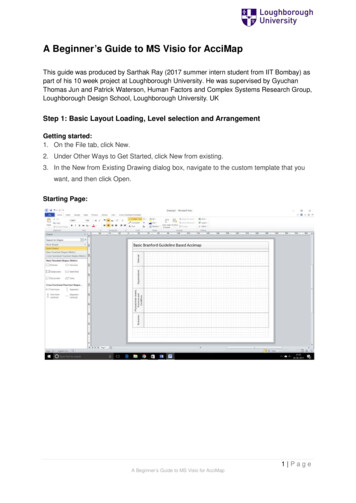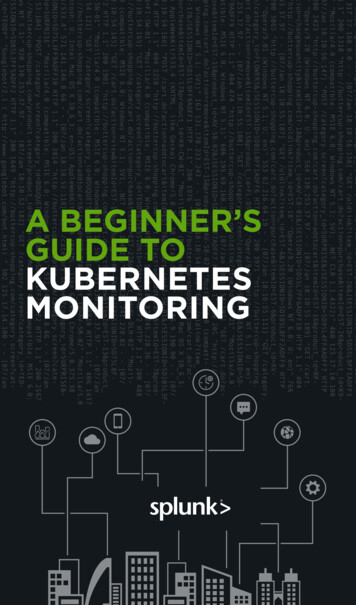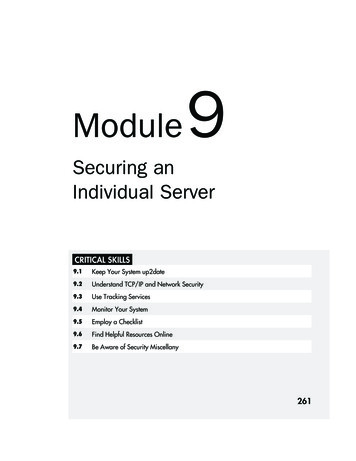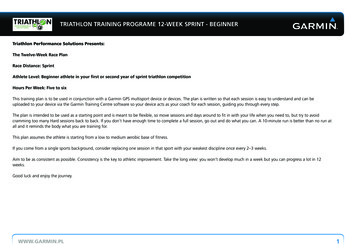
Transcription
Beginner’s Guide 2015 Vanderbilt University
Table of Contents1. INTRODUCTION . 32. GENERAL INFORMATION . 32.1 Access to REDCap . 32.2 Compliance . 32.3 Language for grant and IRB submission . 42.4 Training . 42.5 Support. 43. HOW TO USE REDCAP . 43.1 Definition and wording . 43.2 Project workflow . 53.3 Build and test a project . 53.3.1 Prerequisites .53.3.2 Build a project .63.3.3 Test a project .1113.4 Move a project into production mode . 1113.5 Enter, Review and analyze data . 1113.5.1 Enter data .1113.5.2 Review data .1223.5.3 Analyze data .1333.5.4 De-identification methods for data exporting .143.6 Changes post-production . 1443.7 Close a project . 144University of Chicago Center for Research Informatics REDCap Beginner’s Guide2
1. INTRODUCTIONREDCap is a data management tool that should be used primarily for Research and Quality Improvement studies.REDCap must not be used for collecting clinical data used as primary records for a patient’s care. The purpose of thisdocument is to provide general guidance on the use of REDCap at University of Chicago.Data Management ActivitiesStudyProtocolDefinedata to becollectedBuild &TestDatabaseCollect &ReviewDataDataAnalysis2. GENERAL INFORMATION2.1 Access to REDCapIf you have a BSDAD or UCHAD account, you may log in to REDCap using either one of those accounts. If you do not haveeither a BSDAD or UCHAD account (this includes external collaborators from other institutions), a sponsor with a BSDaccount may request access for you via this online request form. Our CRI Help Desk will confirm the request with thesponsor and then email your login credentials within 24-48 hours.REDCap is a web-based application and can be used from anywhere, outside the University network, and from anydevice (laptop, smartphone, tablets, iPad). The application URL is: https://redcap.uchicago.edu/2.2 ComplianceREDCap is designed with built-in features to address confidentiality and compliance requirements.a. Access control - Access is based on the University’s BSD and UCHAD Active Directories. External collaboratorswho were granted access are added to the BSD Active Directory.At the project level, access control is fully configurable: a project owner can authorize study staff access, asrequired per IRB protocol. Identifiers can be flagged and removed from data exports, depending on userprofiles. See section 3.3.4 for more details on user rights.b. Audit trail - Every operation performed in REDCap is tracked and can be easily retrieved at the project level. (Seelogging feature in REDCap).
c. Centralization of data on local servers - The REDCap application and data are both hosted on University secureservers. A backup is performed nightly.2.3 Language for grant and IRB submissionBoilerplates for citing REDCap, or for grant & IRB documentation regarding REDCap are available .4 TrainingThere is no formal training required to use REDCap but video tutorials and help text are available within each module inREDCap. Also, the ‘Help & FAQ’ tab in REDCap contains a lot of useful information. Additional help is available on theUniversity’s help site at: http://cri.uchicago.edu/redcap-training/2.5 SupportThe REDCap application is developed and deployed by Vanderbilt University. The University’s Center for ResearchInformatics (CRI) is responsible for the maintenance and the administration of the application. CRI provides support toall users: one-on-one consultation, answers to questions/issues, centralization of project change requests, guidance ondata management best practices, and downtime and upgrade communications.3. HOW TO USE REDCAP3.1 Definition and wording Arms: group events into 'arms‘; there may be one or more arms/groups per project. Each arm can have as manyevents as needed.Branching logic: branching Logic may be employed when fields/questions need to be hidden for data entryunder certain conditions.Calendar: project calendar to help organize the patients’ scheduling and keep track of any upcoming events.CRF: Case Report Form.Data Dictionary: Excel file, containing the list of fields of a given project and their associated attributes.Events: allow for the utilization of data collection forms multiple times for any given project record (often usedwhen collecting longitudinal data). An 'event' may be a temporal event in the course of a project, such as aparticipant visit or a task to be performed.Field (or variable or question) may be used interchangeably and represent unique items of data to be collectedand analyzed.File repository: repository that stores and retrieves files and documents used for a project. Whenever a dataexport is performed, the resulting data and syntax files are also stored in the file repository of the project.Instrument: survey page or data entry form.Logging: module that lists all changes made to this project, including data exports, data changes, and thecreation or deletion of users (audit trail).Project status: development, production, draft, inactive and archived.Project type: single survey or data entry form(s) or a mix of a single survey / data entry form(s).Record label: information/variables added to the unique ID of the study (e.g. pat id) to help select the rightrecord during data entry. For example, date of birth or last name can be added as record labels when selecting asubject for data entry. Record labels are displayed only and have no impact when exporting data.University of Chicago Center for Research Informatics REDCap Beginner’s Guide4
3.2 Project workflow*Draft*FinalProtocolProtocolDevelopment modeBuild and test a projectTest dataProduction modeEnter, review, analyze dataReal dataDraft modeUpdate project setupData activities can continueduring the update of thesetup update* ProtocolAmendmentInactive (optional) modeView and analyze dataNo data entry/updateArchived modeProject is closedData analysis finalized* if IRB approval required3.3 Build and test a project3.3.1 PrerequisitesIf collecting data for the purpose of human subject’s research, review and approval of the project by the InstitutionalReview Board is required. Note, the PI name and IRB# must be recorded in REDCap when creating a research project.Define data to be collected before starting building a project.The information that is going to be defined during this step will determine how to build the database.StudyProtoc What?Why?Who?When?How? VariablesData entry formsEvents / VisitsUser RightsBuild DatabaseUniversity of Chicago Center for Research Informatics REDCap Beginner’s Guide5
General recommendations: Protocol determines what data should be collected on the CRF. Data not needed should not be collected: allow for efficient and complete data processing, analysis and reporting. Avoid duplication: do not record the same information into multiple variables for the same event: e.g. DOB and age. Provide instructions to reduce misinterpretations. Be clear and concise with data questions. Provide units to ensure comparable values. Request minimal free text responses: provide pre-defined “choices”. Use “None” and “Not done” to help tracking missing data. Determine if data are collected once or multiple times during the project. Determine if data are used across studies and organizations. Determine how data will be collected: manual key entry, imported from Excel, imported from another study. Determine who will enter data: patients, nurses, study staff, etc.3.3.2Build a project3.3.2.1 Define a project typeThere are three project types available in REDCap:a. Data collection performed only by study teamData entry formsb. Data collection performed only by subjects / study participantsSurveyc. Screening phase before enrolling subjectsSurvey Data entry forms (survey will beused to screen subjects and data entryforms to collect study data).There are two collection formats available for data entry forms: Classic: one record per patient Longitudinal: one record per patient per event, with the possibility of defining multiple arms3.3.2.2 Create instrumentsWhen creating a new project in REDCap, a demographics form is automatically added to the project. This form may bemodified or deleted by the project owner.A given field cannot be used in more than one instrument. The instruments are meant to organize data collection only;they have no impact on the structure of the database or on data extraction.Create instruments and regroup the fields by instrument from a data collection logic standpoint: By modules : i.e. demographics, vitals, medication, etc By type of persons who collect data By data acquisition type: manual data entry or data import Regroup identifiers (PHI) on the same instrument to better protect subject’s data In a longitudinal study, fields that are entered at the same event or within the same arm are grouped together.Instruments may be used at multiple events/armsUniversity of Chicago Center for Research Informatics REDCap Beginner’s Guide6
Longitudinal study example:Data collection instruments may be also downloaded from the public Shared Library of instruments available withinREDCap. If a public instrument is used in a given project, the content may not be modified.3.3.2.3Create fieldsA field is defined by the following attributes: type, label, name, validation, required, identifier, note. In addition, abranching logic can be applied to specify whether or not a question will be displayed, depending on values entered inprevious question(s).Branching LogicField attributesLabel: will be displayed on the data entryforms/survey, reports, PDFsVariable Name: will be column name inthe export file for data analysisValidation: to define data type andimprove data quality: format will bechecked during data entry & data importRequired?: a value will be required duringdata entry/data importIdentifier?: must be set to Yes for all PHIto be able to de-identify data exports andlimit access to PHI within REDCapField Note: to guide data entryUniversity of Chicago Center for Research Informatics REDCap Beginner’s Guide7
Field names With some meaning to identify the content easilyoAvoid using Q1, Q2, Q3oUse underscore for spacesoDo not use ‘ ’ or ‘.’oExamples: Use the word ‘date’ for all date fields Use the word ‘time’ for all time fields MUST begin with a letter, otherwise data exports will not work when using SPSS Cannot end with a period Reserved keywords cannot be used (ALL, AND, BY, EQ, GE, GT, LE, LT, NE, NOT, OR, TO, and WITH) Should be kept short whenever possible (less than 26 characters) oTo avoid spelling errors during programming (analysis)oTo display as column headers in reports and data exportsFor repeating measurements, use the same name and add number (example: weight1, weight2, weight3 )Available field types:The collection of free text must be limited: Use categorical responses (drop-down, radio button or checkbox). REDCap will associate a number (code) witheach answer (label). Consider using checkboxes to collect fields such as medications, symptoms andcomplications. REDCap will create a yes/no column in the dataset for each value that can be checked. Use pre-defined data type (text field with validation), i.e. yes/no, true/false, number, integer, date, datetime,time, zip code, email, phone.Define range minimum / maximum to allow REDCap to perform basic data validation / quality control.All dates in a given study must be collected using the same format.Limit the use of calculated fields in REDCap: Calculations are useful when the resulting value is used to take some action regarding the subject Other calculations should be done outside of REDCapUniversity of Chicago Center for Research Informatics REDCap Beginner’s Guide8
Sample display of field types:dateradiodrop downcheckboxyes/notimetrue/falseslider / visual analogscaleUniversity of Chicago Center for Research Informatics REDCap Beginner’s Guide9
3.3.2.4 Define user rightsThe rights of each user who is granted access to a project must be defined individually, depending on the user’s profile.The table below lists the rights that are recommended per profile. A given person may have more than one profile. It isrecommended to check all access rights on a regular basis during the study.Profile FunctionProject SetupData entryData reviewCalendarData ExportxxxxxData ImportData AnalysisXxXData Comparison (fordouble data entry)Logging (audit trail)(to be limited)File RepositoryUser Rights (to belimited)Data Access Groups(to be used whenmultiple data entrysites)Graphical Data View& StatsData QualityReports & ReportBuilderProject Design k Records(if used)*Records(Create,Delete, Rename) (Dto be limited)xxxxxxxxxxxxxxxxXxXxxCR,DEditRead or EditxxC,D,R (for testing)Data Entry Rights Edit (for testing)(none, read, edit)University of Chicago Center for Research Informatics REDCap Beginner’s Guide10
Users who may not view PHI will have access only to:1.2.3.4.CalendarDe-identified data exportFile repositoryData Entry Rights section: The ‘No Access’ box must be checked for all forms that contain PHI. The ‘Dataentry rights’ section determines the access to data when using the Calendar, building reports and viewingdata with the Graphical Data View tool. Also, if access is given to some data entry forms, the record label(optional customization in REDCap) must not contain PHI.5. Data Quality6. Data exports, Reports, and StatsAll other rights should be unchecked.3.3.3Test a projectThe following tasks are highly recommended before moving a project to production status! Enter test data: using all fields in all instruments and all events to validate instruments and event definition,branching logic and calculated fields. Test data must include different cases that will allow testing all scenarios ofbranching logic and calculated fields. Review test data: open data entry forms, create reports, export data and send the blank CRF to all coinvestigators for review. Have a statistician review your database:oooSend a PDF version of the blank CRF.Send the data dictionary of your database to the statistician. This will clearly communicate any definedbranching logic --- not communicated in the raw data file or meta-data formatting accessible throughthe "Data Export" application. This will also clearly communicate the formulas from calculated fields.Have the Statistician perform a data export to ensure that they do not extract identifiers. They can giveyou feedback regarding the overall design of your database as well as the definition of each field. It isimportant to think through the planned statistical analysis before collecting any data. A statistician canmake sure that you are collecting the fields you need, in the format you need them in, in order toperform the statistical analyses you need.3.4 Move a project into production modeOnce all steps listed in the above sections are performed successfully, the project may be moved into production mode.Test data can be deleted automatically when moving the project into production mode (check off the red box).3.5 Enter, Review and analyze data3.5.1 Enter dataEvery record is identified by a unique key: Study ID (aka Record ID or Subject ID). This key identifier must be the firstquestion on the first form (or survey). It is used by REDCap as the key variable to link all forms/events for a particularsubject.University of Chicago Center for Research Informatics REDCap Beginner’s Guide11
If multiple sites are involved in a study (and the Data Access Group feature is not being used), it is recommended to useconventions in order to group subjects by site. For example: 1 digit for the site and 3 digits for the subject number:Site 1, subject 1: Study ID 1001Site 2, subject 1: Study IDd 2001Data can be key-entered into REDCap, using regular data entry via Data Entry Forms. Double data entry is an optionavailable in REDCap. When this option is enabled, two data entry people will enter data, but instead of saving their dataas normal, the Study ID (or unique record identifier) will have either a "--1" or "--2" appended to it, thus marking it asthe record entered by data entry person 1 or 2. This is how the data entry people can enter data for the samesubject/patient without having a duplicate record. Because all the records entered by the two users will end in the "--#"format, those users can only view the data that they themselves have entered. The "--#" format on the records arehidden from those two users, so to them everything appears as it normally would. However, Reviewers will be able tosee the "--#" appended to the records when viewing them. When Reviewers choose to merge the two records enteredby the data entry people, the new "third" record is saved without the "--#" appended to the end of the record name.The double data entry feature can be turn on by the REDCap Administrator only.Data can be imported into REDCap from a CSV file, using the data import tool. REDCap generates a template with allcolumns. Data must be copied into this template; columns may be removed but the first column must always be kept(e.g. study id). During data import, data can be added or modified but cannot be deleted.3.5.2 Review dataThe data review should start at the beginning of data collection to detect any potential data entry errors and to updatedata entry instructions, if needed.There are different tools available in REDCap to review data:a. Automatic checks: during data entry or data import: REDCap will check automatically during data entry or dataimport for correct formatting of dates, times, numbers, ZIP codes, email addresses and missing values forrequired fields.b. Data review tracking: each data entry form has a status that can be used to track the progress of data entryand/or data review: Incomplete, Unverified and Complete. In addition, the Lock/Unlock feature can be used toprevent accidental data modification or deletion. The e-signature is also an option that can serve as theequivalent of a handwritten signature. Example of use:Note: the use of these tracking tools can be customized for each data entry form and project, depending on theneeds of the project.University of Chicago Center for Research Informatics REDCap Beginner’s Guide12
c. Data Reports and Exports: will allow users to create, save, export and print customized data reports. Datareports can be exported to Excel. Once a report is saved, it can be seen by all users who are granted access tothe project and the Data Report module of the project. For example, a report can be created to check thechronological orders of dates across events.d. Data Stats: This module can display any project data (numeric and coded data) in aggregate graphical formatand as descriptive statistics. If clicking any of the points on the plot, the data entry form of that exact record willopen. Example:e. PDFs: data for one or all records may be downloaded into a single PDF file. Contains the actual page format as seen on the data entry page or survey Includes all data or data from a single instrument May be used if data need to be shared within a short time periodf.Data Quality module: The aim of this module is to help quickly find discrepancies and errors in project data. Thismodule contains rules that can be customized for the project; these rules can be executed at any time duringthe study. Users can exclude any results that they do not wish to see in future results.3.5.3 Analyze dataWhen data review is finalized, the project may be moved into ‘inactive’ mode where you can query/view the data butcannot add/modify/delete the data. The database is ready for statistical analysis.The data export function will allow exporting data in various statistical formats, with the option to select all data orpartial data. Formats available are: SPSS, SAS, R, STATA. The ‘Send-it’ function in REDCap can be used to send files thatcontain sensitive data. Send-It is a secure data transfer application that allows users to upload a file (up to 260 MB insize) and then allows multiple recipients to download the file in a secure manner. Each recipient will receive an emailcontaining a unique download URL, along with a second follow-up email with the password for downloading the file (forgreater security). The file will be stored securely and then later removed from the server after the specified expirationdate. Send-It is the perfect solution for anyone wanting to send files that are too large for email attachments or thatcontain sensitive data.University of Chicago Center for Research Informatics REDCap Beginner’s Guide13
3.5.4 De-identification methods for data exportingREDCap provides advanced de-identification options that can be optionally used when exporting data, such as removingknown identifier fields, removing invalidated text fields, notes fields, or date fields, date shifting and hashing of therecord names. These options provide greater security and data protection when exporting sensitive data out of REDCap.Date shifting: As part of the de-identification options in REDCap, all dates in the database may be shifted so that they donot reflect the actual dates. If the option to have all dates shifted is chosen, they will be shifted by a consistent length oftime for each record, thus preserving the interval between dates. Date shifting leaves the database record intact and willnot affect the actual saved dates in the database. The shifted dates will always be the same for each record whenperforming a data export. The dates are shifted back in time up to 364 days, in which the shifted value is based on theStudy ID using a complex algorithm. Because the shifted value is based on the record name, the amount that dates areshifted is unique for each record, but the shifted amount remains the same within each record to maintain internalconsistency. Date shifting prevents any dates from being used as identifiers for each database record while preservingthe interval between dates.3.6 Changes post-productionChanges to the project design after it is moved to Production are possible. Changes that may potentially affect/changecollected data will be submitted for review. The REDCap Administrator will review changes and they will becomeeffective only after they are approved by the REDCap Administrator. Any changes to the structure of the database, suchas removal of forms, or modifying events in a longitudinal project can only be done by the REDCap Administrator.Altering a database that is in Production can cause data loss. To protect data:(a) Do not change existing variable names, or data stored for those variables will be lost. To restore data that have beenlost in this way, revert to previous variable name(s).(b) Do not change existing form names via a data dictionary upload, or form completeness data will be lost. Form namesmay be changed within the Online Designer without data loss.(c) Do not modify the codes or answers for existing dropdown, radio, or checkbox variables or existing data will be lostor confused. It is only acceptable to add choices to a dropdown, radio, or checkbox field.3.7 Close a projectOnce the data analysis is complete, the project in REDCap should be moved into ‘archive’ mode. This will take theproject offline, and you and other users will no longer be able to access it normally. The project can be brought backonline at any time after being archived by returning to My Projects page and clicking on ‘Show Archived Projects’ at thebottom. It is good practice to remove all user rights from the project except for one user because if the project needsto be put back in production status, the access will be limited to one person.Acknowledgement:The contact of this document was provided by The Children's Hospital of Philadelphia Center for Biomedical Informatics.University of Chicago Center for Research Informatics REDCap Beginner’s Guide14
Determine if data are collected once or multiple times during the project. Determine if data are used across studies and organizations. Determine how data will be collected: manual key entry, imported from Excel, imported from another study. Determine who will enter data:











